Health Assessment Report: Roseanne Chivers Case Study Analysis
VerifiedAdded on 2023/01/16
|7
|1635
|46
Report
AI Summary
This report provides a detailed analysis of a health assessment case study involving a 63-year-old patient, Roseanne Chivers, who exhibited concerning vital signs after participating in an ocean pool swimming class. The report, written by a student nurse, applies the first three phases of the clinical reasoning process to evaluate the patient's condition, including hypothermia, tachycardia, tachypnea, and hypertension. The analysis considers the patient's age, recent bereavement, and the environmental conditions during the swim, exploring potential underlying cardiovascular issues. The report emphasizes the importance of further investigation, including diagnostic tests like echocardiography and electrocardiography, and the development of a patient-centered nursing care plan. The student nurse identifies the need for immediate reporting and management strategies, considering both pharmacological and non-pharmacological interventions to optimize the patient's health outcomes. The report also addresses the potential impact of stress-induced hypertension and the importance of monitoring and adapting the patient's activities to prevent further cardiovascular complications. The report concludes by suggesting a comprehensive approach that includes physical assessments and diagnostic tests to ensure accurate diagnosis and management.
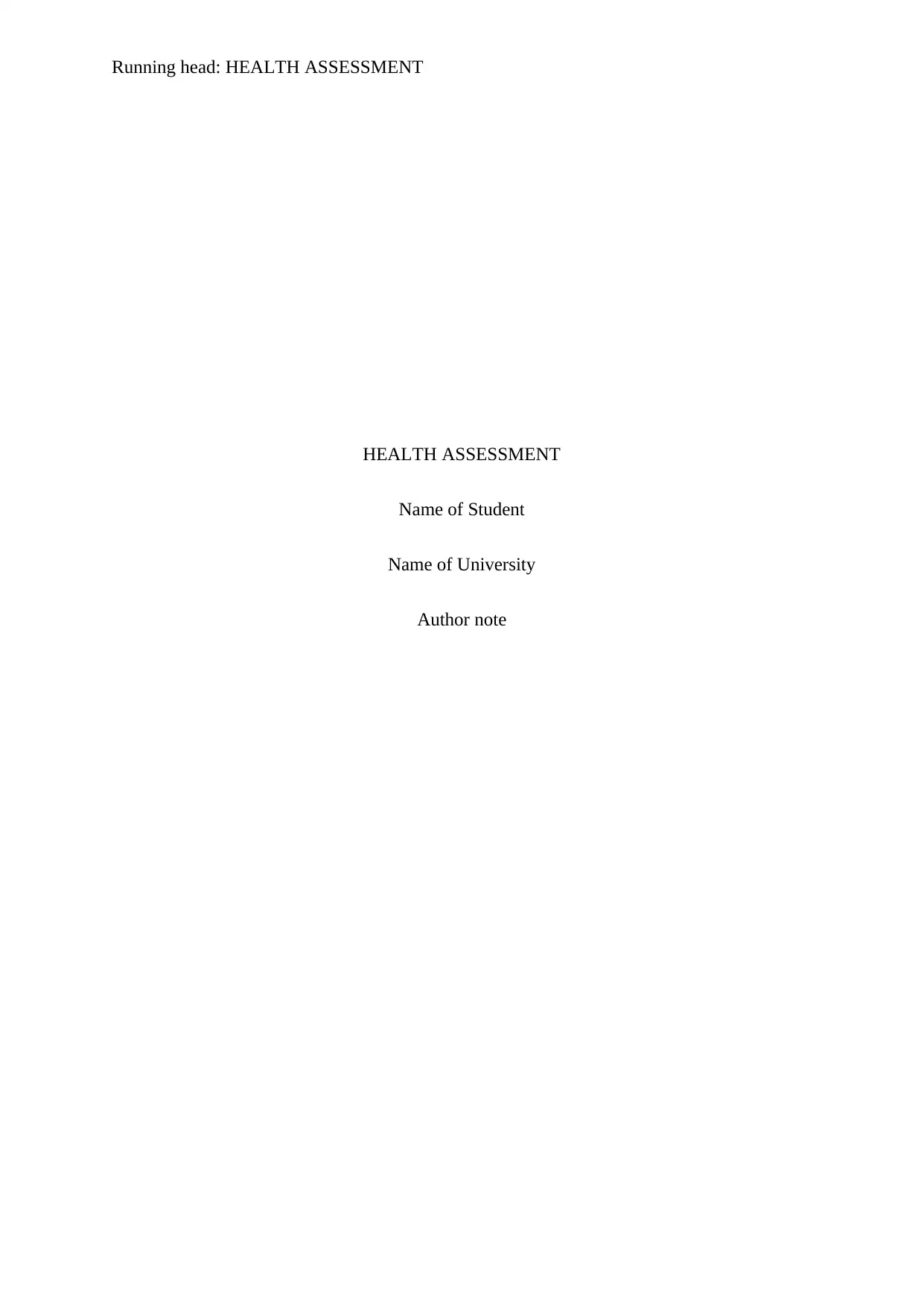
Running head: HEALTH ASSESSMENT
HEALTH ASSESSMENT
Name of Student
Name of University
Author note
HEALTH ASSESSMENT
Name of Student
Name of University
Author note
Paraphrase This Document
Need a fresh take? Get an instant paraphrase of this document with our AI Paraphraser
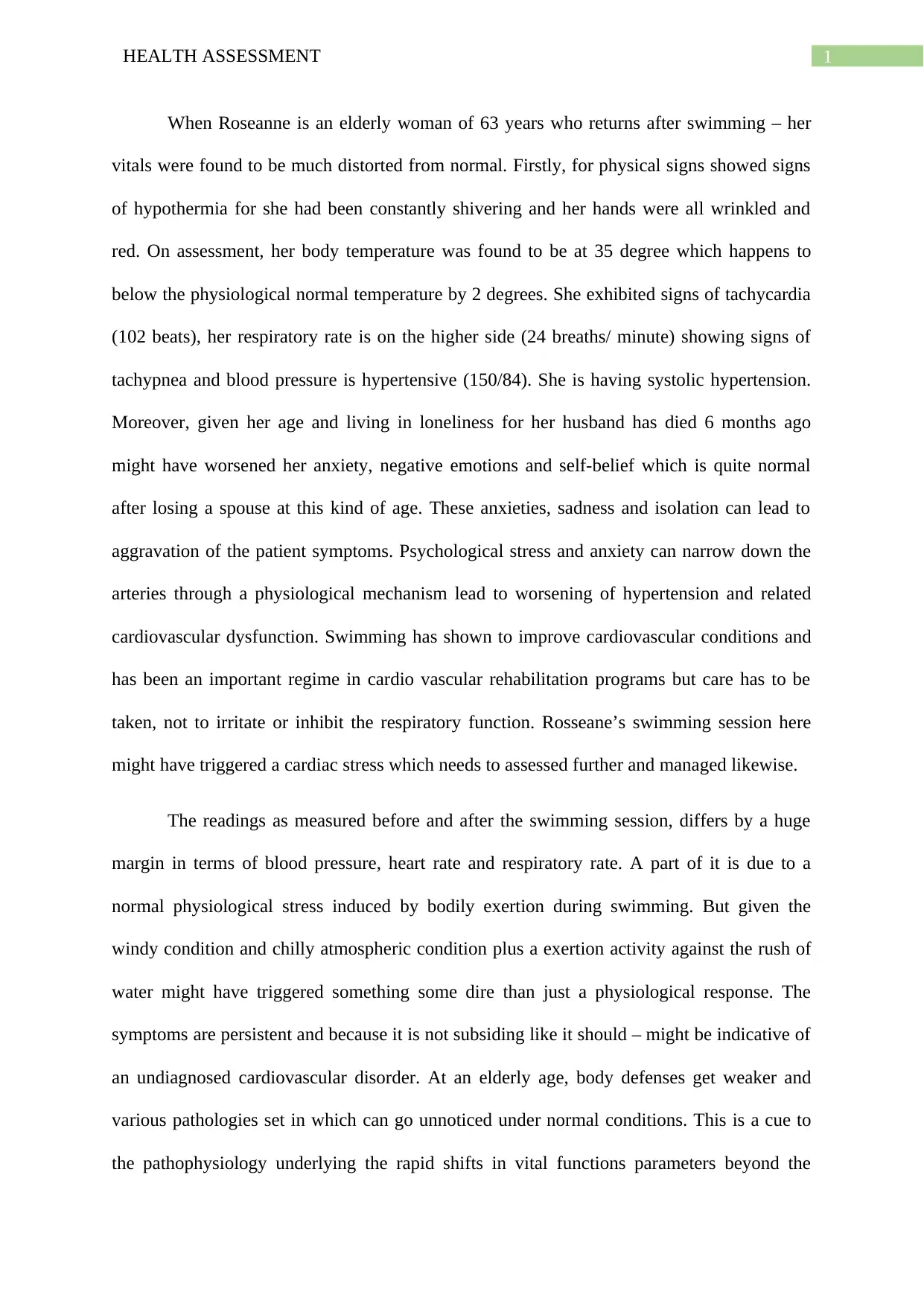
1HEALTH ASSESSMENT
When Roseanne is an elderly woman of 63 years who returns after swimming – her
vitals were found to be much distorted from normal. Firstly, for physical signs showed signs
of hypothermia for she had been constantly shivering and her hands were all wrinkled and
red. On assessment, her body temperature was found to be at 35 degree which happens to
below the physiological normal temperature by 2 degrees. She exhibited signs of tachycardia
(102 beats), her respiratory rate is on the higher side (24 breaths/ minute) showing signs of
tachypnea and blood pressure is hypertensive (150/84). She is having systolic hypertension.
Moreover, given her age and living in loneliness for her husband has died 6 months ago
might have worsened her anxiety, negative emotions and self-belief which is quite normal
after losing a spouse at this kind of age. These anxieties, sadness and isolation can lead to
aggravation of the patient symptoms. Psychological stress and anxiety can narrow down the
arteries through a physiological mechanism lead to worsening of hypertension and related
cardiovascular dysfunction. Swimming has shown to improve cardiovascular conditions and
has been an important regime in cardio vascular rehabilitation programs but care has to be
taken, not to irritate or inhibit the respiratory function. Rosseane’s swimming session here
might have triggered a cardiac stress which needs to assessed further and managed likewise.
The readings as measured before and after the swimming session, differs by a huge
margin in terms of blood pressure, heart rate and respiratory rate. A part of it is due to a
normal physiological stress induced by bodily exertion during swimming. But given the
windy condition and chilly atmospheric condition plus a exertion activity against the rush of
water might have triggered something some dire than just a physiological response. The
symptoms are persistent and because it is not subsiding like it should – might be indicative of
an undiagnosed cardiovascular disorder. At an elderly age, body defenses get weaker and
various pathologies set in which can go unnoticed under normal conditions. This is a cue to
the pathophysiology underlying the rapid shifts in vital functions parameters beyond the
When Roseanne is an elderly woman of 63 years who returns after swimming – her
vitals were found to be much distorted from normal. Firstly, for physical signs showed signs
of hypothermia for she had been constantly shivering and her hands were all wrinkled and
red. On assessment, her body temperature was found to be at 35 degree which happens to
below the physiological normal temperature by 2 degrees. She exhibited signs of tachycardia
(102 beats), her respiratory rate is on the higher side (24 breaths/ minute) showing signs of
tachypnea and blood pressure is hypertensive (150/84). She is having systolic hypertension.
Moreover, given her age and living in loneliness for her husband has died 6 months ago
might have worsened her anxiety, negative emotions and self-belief which is quite normal
after losing a spouse at this kind of age. These anxieties, sadness and isolation can lead to
aggravation of the patient symptoms. Psychological stress and anxiety can narrow down the
arteries through a physiological mechanism lead to worsening of hypertension and related
cardiovascular dysfunction. Swimming has shown to improve cardiovascular conditions and
has been an important regime in cardio vascular rehabilitation programs but care has to be
taken, not to irritate or inhibit the respiratory function. Rosseane’s swimming session here
might have triggered a cardiac stress which needs to assessed further and managed likewise.
The readings as measured before and after the swimming session, differs by a huge
margin in terms of blood pressure, heart rate and respiratory rate. A part of it is due to a
normal physiological stress induced by bodily exertion during swimming. But given the
windy condition and chilly atmospheric condition plus a exertion activity against the rush of
water might have triggered something some dire than just a physiological response. The
symptoms are persistent and because it is not subsiding like it should – might be indicative of
an undiagnosed cardiovascular disorder. At an elderly age, body defenses get weaker and
various pathologies set in which can go unnoticed under normal conditions. This is a cue to
the pathophysiology underlying the rapid shifts in vital functions parameters beyond the
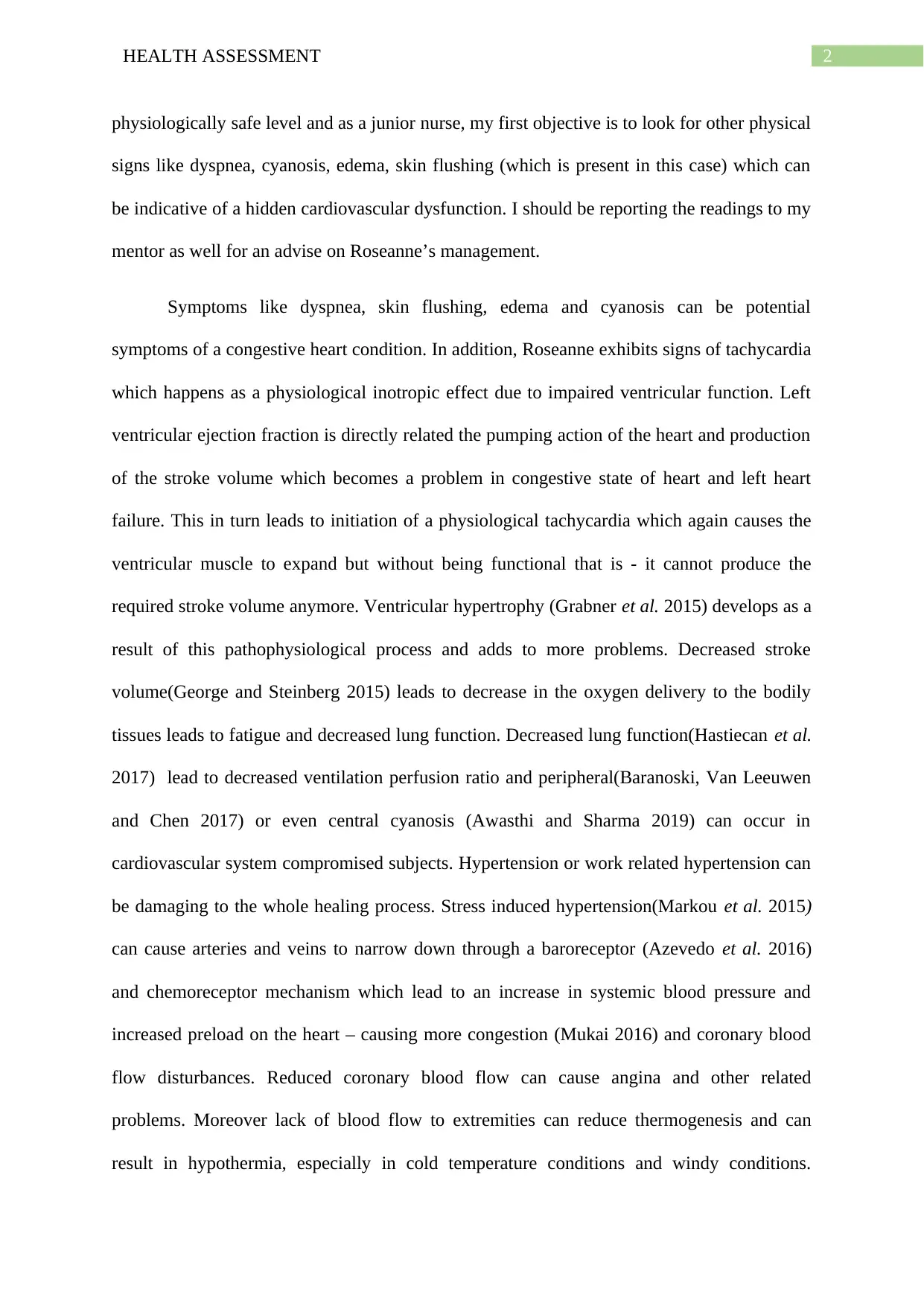
2HEALTH ASSESSMENT
physiologically safe level and as a junior nurse, my first objective is to look for other physical
signs like dyspnea, cyanosis, edema, skin flushing (which is present in this case) which can
be indicative of a hidden cardiovascular dysfunction. I should be reporting the readings to my
mentor as well for an advise on Roseanne’s management.
Symptoms like dyspnea, skin flushing, edema and cyanosis can be potential
symptoms of a congestive heart condition. In addition, Roseanne exhibits signs of tachycardia
which happens as a physiological inotropic effect due to impaired ventricular function. Left
ventricular ejection fraction is directly related the pumping action of the heart and production
of the stroke volume which becomes a problem in congestive state of heart and left heart
failure. This in turn leads to initiation of a physiological tachycardia which again causes the
ventricular muscle to expand but without being functional that is - it cannot produce the
required stroke volume anymore. Ventricular hypertrophy (Grabner et al. 2015) develops as a
result of this pathophysiological process and adds to more problems. Decreased stroke
volume(George and Steinberg 2015) leads to decrease in the oxygen delivery to the bodily
tissues leads to fatigue and decreased lung function. Decreased lung function(Hastiecan et al.
2017) lead to decreased ventilation perfusion ratio and peripheral(Baranoski, Van Leeuwen
and Chen 2017) or even central cyanosis (Awasthi and Sharma 2019) can occur in
cardiovascular system compromised subjects. Hypertension or work related hypertension can
be damaging to the whole healing process. Stress induced hypertension(Markou et al. 2015)
can cause arteries and veins to narrow down through a baroreceptor (Azevedo et al. 2016)
and chemoreceptor mechanism which lead to an increase in systemic blood pressure and
increased preload on the heart – causing more congestion (Mukai 2016) and coronary blood
flow disturbances. Reduced coronary blood flow can cause angina and other related
problems. Moreover lack of blood flow to extremities can reduce thermogenesis and can
result in hypothermia, especially in cold temperature conditions and windy conditions.
physiologically safe level and as a junior nurse, my first objective is to look for other physical
signs like dyspnea, cyanosis, edema, skin flushing (which is present in this case) which can
be indicative of a hidden cardiovascular dysfunction. I should be reporting the readings to my
mentor as well for an advise on Roseanne’s management.
Symptoms like dyspnea, skin flushing, edema and cyanosis can be potential
symptoms of a congestive heart condition. In addition, Roseanne exhibits signs of tachycardia
which happens as a physiological inotropic effect due to impaired ventricular function. Left
ventricular ejection fraction is directly related the pumping action of the heart and production
of the stroke volume which becomes a problem in congestive state of heart and left heart
failure. This in turn leads to initiation of a physiological tachycardia which again causes the
ventricular muscle to expand but without being functional that is - it cannot produce the
required stroke volume anymore. Ventricular hypertrophy (Grabner et al. 2015) develops as a
result of this pathophysiological process and adds to more problems. Decreased stroke
volume(George and Steinberg 2015) leads to decrease in the oxygen delivery to the bodily
tissues leads to fatigue and decreased lung function. Decreased lung function(Hastiecan et al.
2017) lead to decreased ventilation perfusion ratio and peripheral(Baranoski, Van Leeuwen
and Chen 2017) or even central cyanosis (Awasthi and Sharma 2019) can occur in
cardiovascular system compromised subjects. Hypertension or work related hypertension can
be damaging to the whole healing process. Stress induced hypertension(Markou et al. 2015)
can cause arteries and veins to narrow down through a baroreceptor (Azevedo et al. 2016)
and chemoreceptor mechanism which lead to an increase in systemic blood pressure and
increased preload on the heart – causing more congestion (Mukai 2016) and coronary blood
flow disturbances. Reduced coronary blood flow can cause angina and other related
problems. Moreover lack of blood flow to extremities can reduce thermogenesis and can
result in hypothermia, especially in cold temperature conditions and windy conditions.
⊘ This is a preview!⊘
Do you want full access?
Subscribe today to unlock all pages.

Trusted by 1+ million students worldwide

3HEALTH ASSESSMENT
Temperature is regulated by the hypothalamus and these sort of climate can trigger a
differential hypothalamic regulation of body temperature in response to chilly external
conditions. Body temperature can have a huge impact on the blood circular and how
enzymes, organs and tissue functions. Their functions can be readily compromised or
inhibited in low bodily temperature and can lead to further constriction of the blood vessels
resulting in further and gradual increase in systemic blood pressure beyond the controllable
hypertensive level. Shifts in hemodynamics in the body can lead to a development of
cardiogenic shock which can be the pathological state presented in Roseanne. Various types
of pharmacological and non-pharmacologic interventions has to used imperatively as an
integral part of nursing intervention but before that, correct diagnosis of Roseanne health
status has to be done to plan the management in an optimized way. As because, the symptoms
presents after the swimming exercise and it is definite that the tachypnea, tachycardia and
hypertension is exercise induced and vastly differs from the readings when Roseanne is at
rest. Hence, a nursing decision has to be taken whether swimming sessions should be allowed
for the concerned subject and what does activities should be stopped immediately so as not to
aggravate the present cardiovascular conditions of the patient. The cues must be reasoned
correctly with clinical knowledge and a patient centered nursing care plan has to be
formulated.
Further tests like echocardiography , electrocardiography, tread mill test and even
holster monitoring based on the degree of cardiovascular severity – has to done as a
important part of diagnostic regime to confirm the cues and pathophysiology discussed in the
above discussion. Moreover, a Doppler test would be imperative in diagnosing the
functionality of left ventricle with respect to left ventricular ejection fraction. The walls of the
ventricles should be checked for any thickening and any occlusion in the coronary artery can
be diagnosed with angiography. In addition to this, a daily nursing physical assessment so as
Temperature is regulated by the hypothalamus and these sort of climate can trigger a
differential hypothalamic regulation of body temperature in response to chilly external
conditions. Body temperature can have a huge impact on the blood circular and how
enzymes, organs and tissue functions. Their functions can be readily compromised or
inhibited in low bodily temperature and can lead to further constriction of the blood vessels
resulting in further and gradual increase in systemic blood pressure beyond the controllable
hypertensive level. Shifts in hemodynamics in the body can lead to a development of
cardiogenic shock which can be the pathological state presented in Roseanne. Various types
of pharmacological and non-pharmacologic interventions has to used imperatively as an
integral part of nursing intervention but before that, correct diagnosis of Roseanne health
status has to be done to plan the management in an optimized way. As because, the symptoms
presents after the swimming exercise and it is definite that the tachypnea, tachycardia and
hypertension is exercise induced and vastly differs from the readings when Roseanne is at
rest. Hence, a nursing decision has to be taken whether swimming sessions should be allowed
for the concerned subject and what does activities should be stopped immediately so as not to
aggravate the present cardiovascular conditions of the patient. The cues must be reasoned
correctly with clinical knowledge and a patient centered nursing care plan has to be
formulated.
Further tests like echocardiography , electrocardiography, tread mill test and even
holster monitoring based on the degree of cardiovascular severity – has to done as a
important part of diagnostic regime to confirm the cues and pathophysiology discussed in the
above discussion. Moreover, a Doppler test would be imperative in diagnosing the
functionality of left ventricle with respect to left ventricular ejection fraction. The walls of the
ventricles should be checked for any thickening and any occlusion in the coronary artery can
be diagnosed with angiography. In addition to this, a daily nursing physical assessment so as
Paraphrase This Document
Need a fresh take? Get an instant paraphrase of this document with our AI Paraphraser
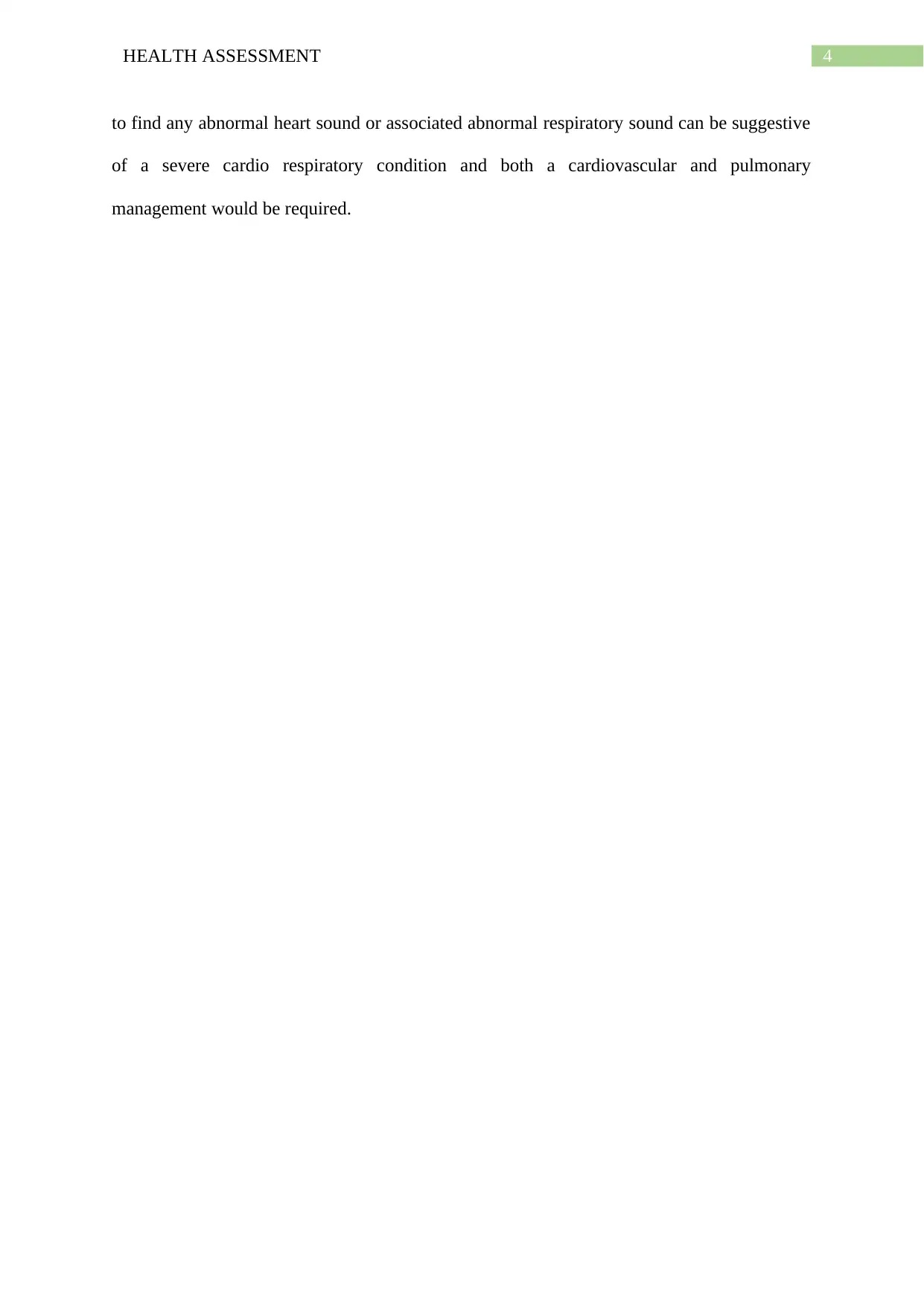
4HEALTH ASSESSMENT
to find any abnormal heart sound or associated abnormal respiratory sound can be suggestive
of a severe cardio respiratory condition and both a cardiovascular and pulmonary
management would be required.
to find any abnormal heart sound or associated abnormal respiratory sound can be suggestive
of a severe cardio respiratory condition and both a cardiovascular and pulmonary
management would be required.
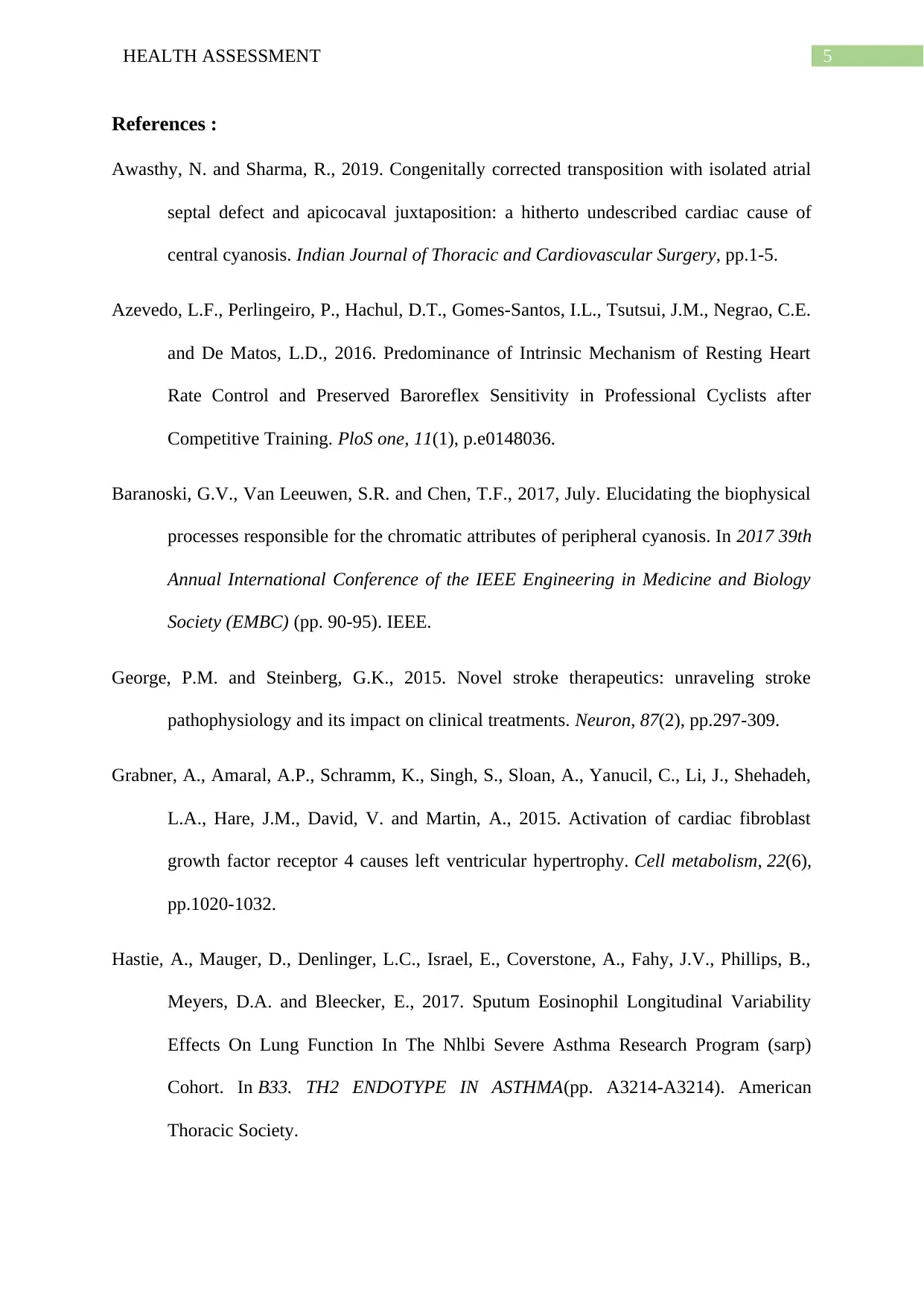
5HEALTH ASSESSMENT
References :
Awasthy, N. and Sharma, R., 2019. Congenitally corrected transposition with isolated atrial
septal defect and apicocaval juxtaposition: a hitherto undescribed cardiac cause of
central cyanosis. Indian Journal of Thoracic and Cardiovascular Surgery, pp.1-5.
Azevedo, L.F., Perlingeiro, P., Hachul, D.T., Gomes-Santos, I.L., Tsutsui, J.M., Negrao, C.E.
and De Matos, L.D., 2016. Predominance of Intrinsic Mechanism of Resting Heart
Rate Control and Preserved Baroreflex Sensitivity in Professional Cyclists after
Competitive Training. PloS one, 11(1), p.e0148036.
Baranoski, G.V., Van Leeuwen, S.R. and Chen, T.F., 2017, July. Elucidating the biophysical
processes responsible for the chromatic attributes of peripheral cyanosis. In 2017 39th
Annual International Conference of the IEEE Engineering in Medicine and Biology
Society (EMBC) (pp. 90-95). IEEE.
George, P.M. and Steinberg, G.K., 2015. Novel stroke therapeutics: unraveling stroke
pathophysiology and its impact on clinical treatments. Neuron, 87(2), pp.297-309.
Grabner, A., Amaral, A.P., Schramm, K., Singh, S., Sloan, A., Yanucil, C., Li, J., Shehadeh,
L.A., Hare, J.M., David, V. and Martin, A., 2015. Activation of cardiac fibroblast
growth factor receptor 4 causes left ventricular hypertrophy. Cell metabolism, 22(6),
pp.1020-1032.
Hastie, A., Mauger, D., Denlinger, L.C., Israel, E., Coverstone, A., Fahy, J.V., Phillips, B.,
Meyers, D.A. and Bleecker, E., 2017. Sputum Eosinophil Longitudinal Variability
Effects On Lung Function In The Nhlbi Severe Asthma Research Program (sarp)
Cohort. In B33. TH2 ENDOTYPE IN ASTHMA(pp. A3214-A3214). American
Thoracic Society.
References :
Awasthy, N. and Sharma, R., 2019. Congenitally corrected transposition with isolated atrial
septal defect and apicocaval juxtaposition: a hitherto undescribed cardiac cause of
central cyanosis. Indian Journal of Thoracic and Cardiovascular Surgery, pp.1-5.
Azevedo, L.F., Perlingeiro, P., Hachul, D.T., Gomes-Santos, I.L., Tsutsui, J.M., Negrao, C.E.
and De Matos, L.D., 2016. Predominance of Intrinsic Mechanism of Resting Heart
Rate Control and Preserved Baroreflex Sensitivity in Professional Cyclists after
Competitive Training. PloS one, 11(1), p.e0148036.
Baranoski, G.V., Van Leeuwen, S.R. and Chen, T.F., 2017, July. Elucidating the biophysical
processes responsible for the chromatic attributes of peripheral cyanosis. In 2017 39th
Annual International Conference of the IEEE Engineering in Medicine and Biology
Society (EMBC) (pp. 90-95). IEEE.
George, P.M. and Steinberg, G.K., 2015. Novel stroke therapeutics: unraveling stroke
pathophysiology and its impact on clinical treatments. Neuron, 87(2), pp.297-309.
Grabner, A., Amaral, A.P., Schramm, K., Singh, S., Sloan, A., Yanucil, C., Li, J., Shehadeh,
L.A., Hare, J.M., David, V. and Martin, A., 2015. Activation of cardiac fibroblast
growth factor receptor 4 causes left ventricular hypertrophy. Cell metabolism, 22(6),
pp.1020-1032.
Hastie, A., Mauger, D., Denlinger, L.C., Israel, E., Coverstone, A., Fahy, J.V., Phillips, B.,
Meyers, D.A. and Bleecker, E., 2017. Sputum Eosinophil Longitudinal Variability
Effects On Lung Function In The Nhlbi Severe Asthma Research Program (sarp)
Cohort. In B33. TH2 ENDOTYPE IN ASTHMA(pp. A3214-A3214). American
Thoracic Society.
⊘ This is a preview!⊘
Do you want full access?
Subscribe today to unlock all pages.

Trusted by 1+ million students worldwide
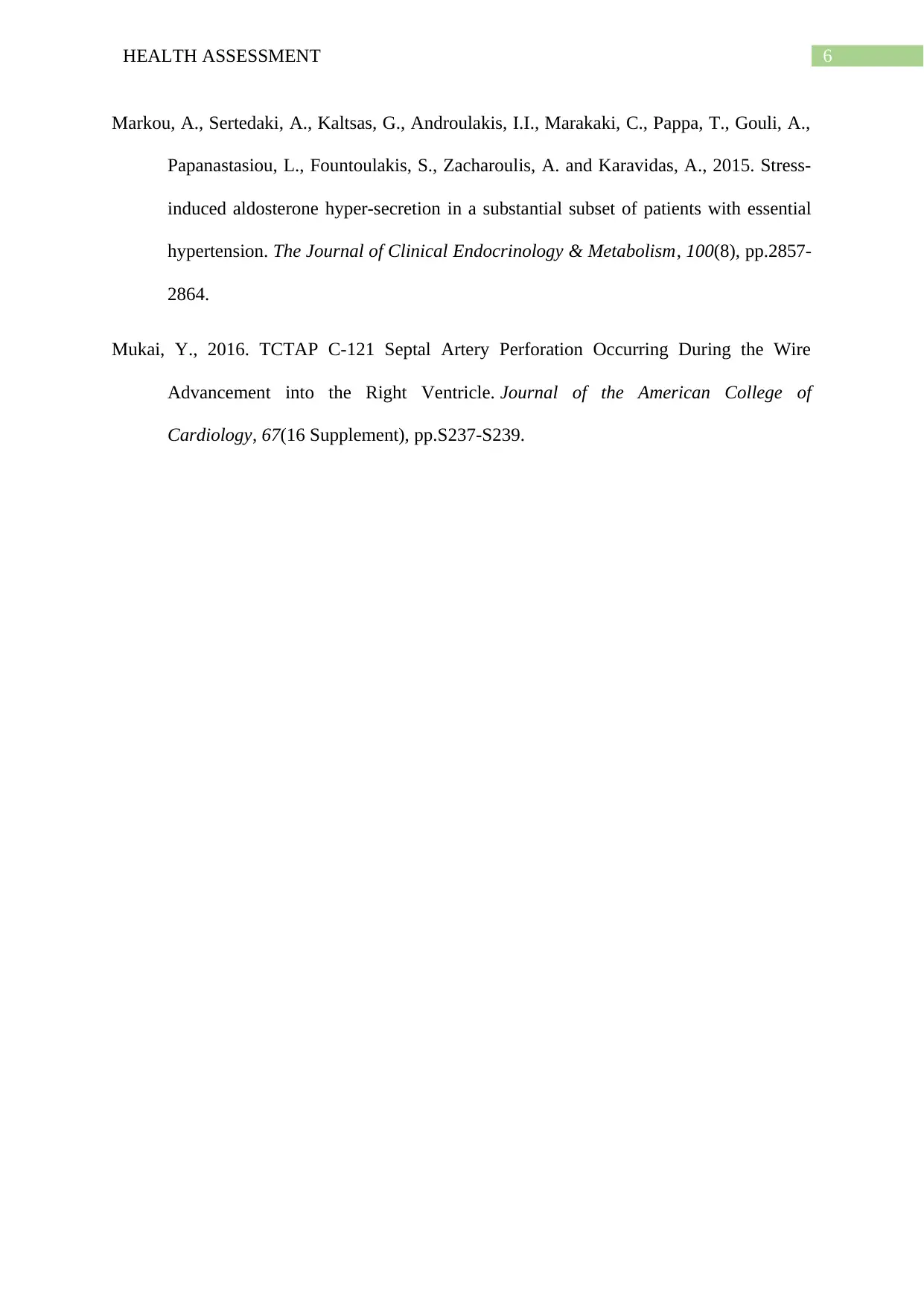
6HEALTH ASSESSMENT
Markou, A., Sertedaki, A., Kaltsas, G., Androulakis, I.I., Marakaki, C., Pappa, T., Gouli, A.,
Papanastasiou, L., Fountoulakis, S., Zacharoulis, A. and Karavidas, A., 2015. Stress-
induced aldosterone hyper-secretion in a substantial subset of patients with essential
hypertension. The Journal of Clinical Endocrinology & Metabolism, 100(8), pp.2857-
2864.
Mukai, Y., 2016. TCTAP C-121 Septal Artery Perforation Occurring During the Wire
Advancement into the Right Ventricle. Journal of the American College of
Cardiology, 67(16 Supplement), pp.S237-S239.
Markou, A., Sertedaki, A., Kaltsas, G., Androulakis, I.I., Marakaki, C., Pappa, T., Gouli, A.,
Papanastasiou, L., Fountoulakis, S., Zacharoulis, A. and Karavidas, A., 2015. Stress-
induced aldosterone hyper-secretion in a substantial subset of patients with essential
hypertension. The Journal of Clinical Endocrinology & Metabolism, 100(8), pp.2857-
2864.
Mukai, Y., 2016. TCTAP C-121 Septal Artery Perforation Occurring During the Wire
Advancement into the Right Ventricle. Journal of the American College of
Cardiology, 67(16 Supplement), pp.S237-S239.
1 out of 7
Related Documents
Your All-in-One AI-Powered Toolkit for Academic Success.
+13062052269
info@desklib.com
Available 24*7 on WhatsApp / Email
![[object Object]](/_next/static/media/star-bottom.7253800d.svg)
Unlock your academic potential
Copyright © 2020–2025 A2Z Services. All Rights Reserved. Developed and managed by ZUCOL.





